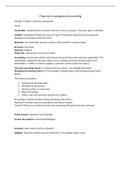Summary
Financial and management accounting samenvatting Chapter 1, 2, 3
- Course
- Institution
A summary of Chapter 1, 2, 3 from finance and management accounting of the powerpoints, lectures and additional information from the books + examples. Based on International business Year 1 quarter 1 and 2.
[Show more]



